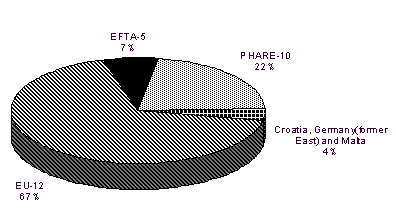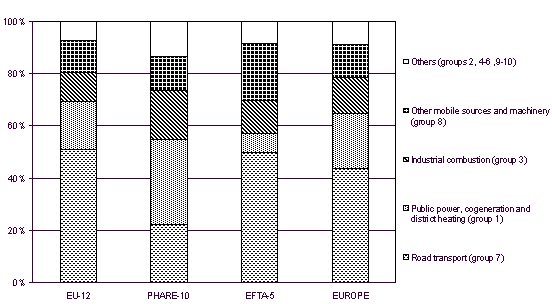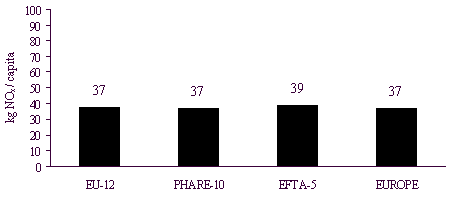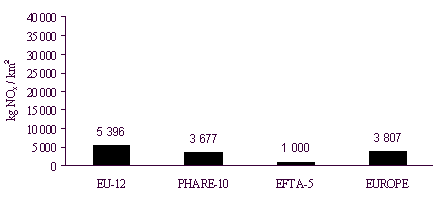2. NITROGEN OXIDES -
NOx
2.1 NOx-emissions by countries
The 1990 annual total NOx-emissions for
EUROPE were estimated to be 18 million tonnes as NO2. These emissions broken
down by EU-12, EFTA-5 and PHARE-10 countries are shown in figure 2.1. The largest
contributor were the EU-12 countries with 67%, second largest the PHARE-10 countries with
22%; the EFTA-5 countries contributed 7% and Germany (former East), Croatia and Malta 4%.
Figure 2.1: Contribution in % to the European total
NOx-emissions

Figure 2.2 shows the relative contribution of
individual countries to the total of 18 million tonnes. In 1990 the largest contributing
countries were the United Kingdom (15%), Germany (former West; 13%) and Italy (11%); the
smallest contributing countries were Malta (0.06%), Luxembourg (0.1%), Slovenia (0.3%) and
Estonia (0.4%). These differences are due to different size of population and different
per capita emissions (see also paragraph 2.3).
Figure 2.2: Contribution in % of each country to the
EUROPEAN total NOx-emissions

2.2 NOx-emissions per group
More than fifty percent of the NOx-emissions
for EUROPE in 1990 were produced by road transport (group 7) and other mobile sources and
machinery (group 8). Forty percent of the NOx-emissions for EUROPE resulted
from emissions of group 1 (public power, cogeneration and district heating), group 2
(commercial, institutional and residential combustion) and group 3 (industrial combustion)
together. Group 7 contributed the largest share with 44%, groups 1, 3 and 8 were the
groups with the next largest contribution of 21, 14 and 13%. The remaining 8% of the total
emissions can be attributed to emissions of the group 2 (commercial, institutional and
residential combustion), group 4 (production processes) and group 9 (waste treatment and
disposal).
The split of the NOx-emissions into
groups for EU-12, EFTA-5 and PHARE-10 countries is quite similar compared to the split for
EUROPE with the exception of the relative large contribution of group 1 with 32% and a
relative small contribution of group 7 with 22% for the PHARE-10 countries and a larger
contribution of group 8 with 22% for the EFTA-5 countries (see figure 2.3).
The differences of contributions of the main source
groups 7, 1, 3, and 8 to the total emissions are larger between countries than these
groups (see also table 2.1). The contribution of group 7 in the
countries ranges from 68% (Austria) to 9% (Romania), of group 1 from 42% (Czech Republic)
to 0.4% (Norway), group 3 from 47% (Luxembourg) to nearly 0.4% (Greece) and group 8 from
50% (Norway) to 2% (Belgium, Wallonie region).
It is intended to explain these significant
differences in a special NOx-report. However it is evident from these
differences in the relative contribution of source groups to a countries total emissions
that strategies for reduction of NOx-emission will need individual solutions as
well as common elements.
Figure 2.3: Contribution in % of source groups to
the European NOx-emissions

2.3 NOx-emissions
per capita
Only anthropogenic emissions are expected to be
related to population for these calculations. Therefore group 11 (nature) has been
excluded.
For EUROPE the average NOx-emissions per
capita were 37 kg/capita. Compared to this number the per capita NOx-emissions
were only little larger for the EFTA-5 countries with 39 kg/capita, equal for the EU-12
and PHARE-10 countries with 37 kg/capita. This comparison is also shown in figure 2.4 and table 9.
Again the differences are much larger if individual
countries are compared; the largest NOx-emissions per capita were estimated for
the Czech Republic (75 kg/capita) and the next largest ones for Luxembourg (61 kg/capita),
Norway (55 kg/capita) and Finland and Greece (each 54 kg/capita); the smallest per capita
emissions for NOx were calculated for Hungary (18 kg/capita), Portugal and
Croatia each (21 kg/capita), Romania (24 kg/capita) and Switzerland (25 kg/capita). Figure
2.5 shows the countries ranked according their per capita emissions. The already mentioned
special report for NOx will analyse these differences in the per capita
emissions for NOx, the smallest per capita emissions being almost a factor of 4
smaller compared to the largest number.
Figure 2.4: NOx-emissions per capita for
EUROPE

Figure 2.5: NOx-emissions per capita for
individual countries

2.4 NOx-emissions per km2
The emissions per km2 have been
calculated from the total emissions, the emissions of group 11 (nature) having been
included in this case.
For EUROPE the average NOx-emissions per
km2 were estimated as 3 807 kg/km2. Compared to this number the per
km2 NOx-emissions were 3% smaller for the PHARE-10 countries with 3
677 kg/km2, 42% larger for the EU-12 countries with
5 396 kg/km2 and 74% smaller for the EFTA-5 countries with 1 000 kg/km2.
This comparison is also shown in figure 2.6 and table 10.
Figure 2.6: NOx-emissions per km2
for EUROPE

Again the differences are much larger if individual
countries are compared: the largest NOx-emissions per km2 were for
the Malta (36 614 kg/km2) and the next largest ones for Netherlands (13 887
kg/km2) and Belgium, Flemish region (13 439 kg/km2); the smallest
emissions per km2 for NOx were for Norway (717 kg/km2),
Sweden (767 kg/km2) and Finland (794 kg/km2). Figure 2.7 shows the
countries ranked according their NOx-emission per km2. The
differences in the emissions per km2 between countries are much larger compared
to the per capita emissions. The smallest number being 51 times smaller than the largest
number.
Figure 2.7: NOx-emissions per km2
for individual countries

Table 2.1: Nitrogen oxides
emissions per country and group








Document Actions
Share with others